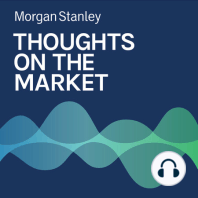4 min listen

Seth Carpenter: Are Higher Rates Permanent?
Seth Carpenter: Are Higher Rates Permanent?
ratings:
Length:
3 minutes
Released:
Oct 16, 2023
Format:
Podcast episode
Description
The recent rise in long term yields and economic tightening raises the question of how restrictive U.S. financial conditions have become.----- Transcript -----Welcome to Thoughts on the Market. I'm Seth Carpenter, Morgan Stanley's Chief Global Economist, and along with my colleagues bringing you a variety of perspectives. Today, I'll be talking about the tightening of financial conditions. It's Monday, October 16th at 10 a.m. in New York. The net selloff in U.S. interest rates since May prompts the question of how restrictive financial conditions have become in the United States. Federal Reserve leaders highlighted the tightening in conditions in recent speeches, with emphasis on the recent rise in long term yields. One lens on this issue is the Financial Conditions index, and the Morgan Stanley version suggests that the recent rate move is the equivalent of just under two Fed hikes since the September FOMC meeting. Taken at face value, it sustained these tight conditions will restrain economic activity over time. Put differently, the market is doing additional tightening for the Fed. Before the rally in rates this week, the Morgan Stanley Financial Conditions Index reached the highest level since November 2022, and the move was the equivalent of more than 2 25 basis point hikes since the September FOMC meeting. Of course, the mapping to Fed funds equivalence is just one approximation among many. When Fed staff tried to map QE effects into Fed funds equivalence, they would have assessed the 50 basis point move in term premiums we have seen as a 200 basis point move in hiking the Fed funds rate. What does the FCI mean for inflation and growth? Well, Morgan Stanley forecasts have been fairly accurate on the inflation trend throughout 2023, although we have underestimated growth. We think that core PCE inflation gets below 3% by the first quarter of next year. For growth, the key question is whether the sell off is exogenous, that is if it's unrelated to the fundamentals of the economy and whether it persists. A persistent exogenous rise in rates should slow the economy, and over time the Fed would need to adjust the path of policy lower in order to offset that drag. The more drag that comes from markets, the less drag the Fed would do with policy. But if instead the sell off is endogenous, that is, the higher rates reflect just a fundamentally stronger economy, either because of more fiscal policy or higher productivity growth or both, the growth need not slow at all and rates can stay high forever. Well, what does the FCI mean then, for the Fed? Bond yields have contributed about 2/3's of the rise in the Financial conditions index, and the Fed seems to have taken note. In a panel moderated by our own Ellen Zentner last Monday, Vice Chair Jefferson was a key voice suggesting that the rate move could forestall another hike. The Fed, however, must confront the same two questions. Is the tightening endogenous or exogenous, and will it persist? If rates continued their rally over the next several weeks and offset the tightening, then there's no material effect. But the second question of exogeneity is also critical. If the selloff was exogenous, then the tightening should hurt growth and the Fed will have to adjust policy in response. If instead the higher rates are an endogenous reaction, then there may be more underlying strength in the economy than our models imply and the shift higher in rates could be permanent. Thanks for listening. If you enjoy the show, please leave a review on Apple Podcasts or share Thoughts on the Market with a friend or colleague today.
Released:
Oct 16, 2023
Format:
Podcast episode
Titles in the series (100)
Andrew Sheets: A Second (and Third) Opinion for Equity Markets by Thoughts on the Market